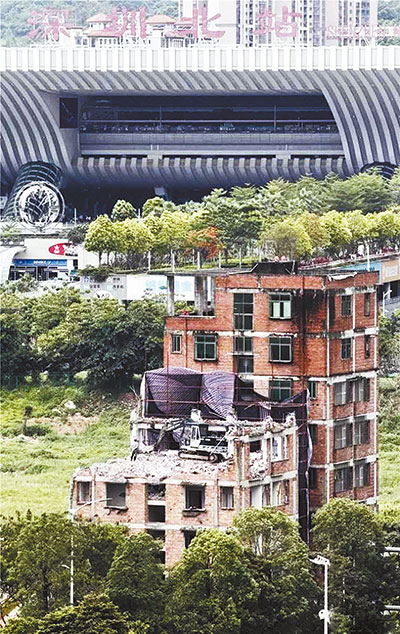
THREE buildings located near Shenzhen North Railway Station have long been dubbed “nail buildings” as they were supposed to be demolished 10 years ago but the homeowners have refused to move out.
The owner of one of the buildings recently reached an agreement with the government and the building is being demolished, the Southern Metropolis Daily reported yesterday.
Half of the building has been dismantled by an excavator as of Tuesday morning. The Minzhi Subdistrict Office is still negotiating with the owners of the other two buildings, according to the report.
A middle-aged man, who was picking up sweet potato leaves in the front yard of one building Tuesday morning, said that he was looking after the building for the homeowner. “I feel exhausted. People should let it go when it’s the right time,” he said.
A resident from the nearby neighborhood said that last year there were many taxi drivers renting apartments in these buildings, but most of the tenants terminated their leases after the government installed surveillance cameras in the area.
According to the spokesperson of the Minzhi Subdistrict Office, these buildings, located in Huaqiao New Village, are occupying land that had been planned by the city government for the construction of roads and green spaces for Shenzhen North Railway Station.
One of the homeowners, surnamed Yang, spent 180,000 yuan (US$26,132) to buy the 120-square-meter property in 1995 and built the building in 2003. Yang said that her building wasn’t illegal because she has legal property certificates.
However, the subdistrict office’s spokesperson said that Yang had obtained a construction land use permit in 1993 with only half-a-year of validity, and Yang didn’t start building until 2003.
The spokesperson said homeowners could obtain as much as 6,548 yuan per square meter for compensation, calculated based on their home size, if they agree to move out. However, homeowners won’t be compensated with equal-sized commercial housing because they are not original residents of the village, according to the spokesperson.
(Zhang Yang)
| 
